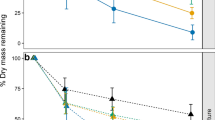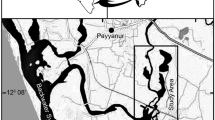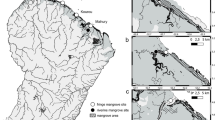Abstract
Mangrove species are broadly classified as ‘true mangroves’ and ‘mangrove associates’. We hypothesized that the leaf litter decomposition rates of true mangroves differ significantly from the mangrove associates under the same ecological and bio-climatic conditions. In order to test this hypothesis, the leaf litter decay rates of 24 true mangrove species and 10 mangrove associates along with the concomitant carbon and nitrogen dynamics of the litters were studied in the tropical mangrove forest of Sundarban by means of litter bags. The decomposition was monitored for six consecutive weeks in the pre-monsoon, monsoon and post-monsoon season. All the species in general went through a rapid decay phase in the first 2 weeks, however, the rate substantially decreased in the following 4 weeks. Most of the species studied had significant seasonal variability (p < 0.05) in the decay rate. Species-specific decay was highest throughout the monsoon and least during the post-monsoon season. The mean dry weight composition (i.e. percentage of dry weight of the leaf litters remaining at the end of weekly intervals) of the true mangroves was 10–12 % higher than the mangrove associates throughout the sampling period. The mean decay constants (K in week−1) of the true mangroves were 0.15 ± 0.05, 0.20 ± 0.06 and 0.16 ± 0.05 in the pre-monsoon, monsoon and post-monsoon season respectively. The mangrove associates had significantly higher decay constants in the respective seasons that followed the order 0.23 ± 0.09, 0.25 ± 0.06 and 0.24 ± 0.09. As a consequence, the computed mean half-life period of the true mangrove litters (32 ± 11 days) was much higher than the mangrove associates (23 ± 11 days). This showed that collectively the leaf litters of mangrove associates degraded at a much faster rate than the true mangroves throughout the annual cycle and thus our hypothesis was justified.




Similar content being viewed by others
References
Abbot J, Marohasy J (2014) The excavation and cultivation in containers of mature grey mangroves, Avicennia marina. Wetl Ecol Manag 22:641–646
Akatsuka Y, Asaeda T, Tanaka N, Vu TC (2002) Diminishing mangrove forests and spreading erosion of river banks due to Inland waterway navigation in the Mekong delta [online]. In: Cox RJ (ed) 30th PIANC-AIPCN Congress. Institution of Engineers, Sydney, pp 1571–1579
Alongi DM (1998) Coastal ecosystem processes. CRC Press, New York
Alongi DM (2012) Carbon sequestration in mangrove forests. Carbon Manag 3:313–322
Alongi DM, Sasekumar A, Chong VC, Pfitzner J, Trott LA, Tirendi F, Dixon P, Brunskill GJ (2004) Sediment accumulation and organic material flux in a managed mangrove ecosystem: estimates of land-ocean-atmosphere exchange in peninsular Malaysia. Mar Geol 208:383–402
Ananda K, Sridhar KR, Raviraja NS, Bärlocher F (2008) Breakdown of fresh and dried Rhizophora mucronata leaves in a mangrove of Southwest India. Wetl Ecol Manag 16:1–9
Asaeda T, Kalibbala M (2009) Modelling growth and primary production of the marine mangrove (Rhizophora apiculata BL): a dynamic approach. J Exp Mar Biol Ecol 371:103–111
Asaeda T, Nam LH, Hietz P, Tanaka N, Karunaratne S (2002) Seasonal fluctuations in live and dead biomass of Phragmites australis as described by a growth and decomposition model: implications of duration of aerobic conditions for litter mineralization and sedimentation. Aquat Bot 73:223–239
Ashton EC (1999) Biodiversity in two managed mangrove forests in Peninsular Malaysia. Doctoral thesis, University of York, p 411
Ashton EC, Hogarth PJ, Ormond R (1999) Breakdown of mangrove litter in a managed mangrove forest in Peninsular Malaysia. In: Dodd RS (ed) Diversity and function in mangrove ecosystems, vol 413. Springer, New York, pp 77–88
Bärlocher F (1992) The ecology of aquatic hyphomycetes, vol 94. Springer, Berlin
Bärlocher F (1997) Pitfalls of traditional techniques when studying decomposition in aquatic habitats. Limnetica 13:1–11
Benner R, Hodson RE (1985) Microbial degradation of the leachable and lignocellulose components of leaves and wood from Rhizophora mangle in a tropical mangrove swamp. Mar Ecol Prog Ser 23:221–230
Benner R, Hodson RE, Kirchman D (1988) Bacterial abundance and production on mangrove leaves during initial stages of leaching and biodegradation. Arch Hydrobiol 31:19–26
Biswas H, Mukhophadhya SK, Sen S, Jana TK (2007) Spatial and temporal patterns of methane dynamics in the tropical mangrove dominated estuary, NE coast of Bay of Bengal, India. J Mar Syst 68:55–64
Bokhorst S, Wardle DA (2013) Microclimate within litter bags of different mesh size: implications for the ‘arthropod effect’ on litter decomposition. Soil Biol Biochem 58:147–152
Bosire JO, Dahdouh-Guebas F, Kairo JG, Cannicci S, Koedam N (2004) Spatial macrobenthic variations in a tropical mangrove Bay. Biodivers Conserv 13:1059–1074
Bosire JO, Dahdouh-Guebas F, Kairo JG, Kazungu J, Dehairs F, Koedam N (2005) Litter degradation and CN dynamics in reforested mangrove plantations at Gazi Bay, Kenya. Biol Conserv 126:287–295
Bouillon S, Koedam N, Raman AV, Dehairs F (2002) Primary producers sustaining macro-invertebrate communities in intertidal mangrove forests. Oecologia 130:441–448
Breithaupt JL, Smoak JM, Smith TJ, Sanders CJ, Hoare A (2012) Organic carbon burial rates in mangrove sediments: strengthening the global budget. Glob Biogeochem Cycles. doi:10.1029/2012GB004375
Chale FMM (1993) Degradation of mangrove leaf litter under aerobic conditions. Hydrobiology 257:177–183
Chanda A, Akhand A, Manna S, Dutta S, Das I, Hazra S, Rao KH, Dadhwal VK (2014) Measuring day-time CO2 fluxes from the inter-tidal mangrove soils of Indian Sundarban. Environ Earth Sci 72:417–427
Chowdhury A, Maiti SK (2014) A comparative study of variations in mangrove biodiversity at central and eastern parts of the Sundarban Biosphere Reserve, India. Am Int J Res Form Appl Nat Sci 5:27–31
Cox PM, Betts RA, Jones CD, Spall SA, Totterdell IJ (2000) Acceleration of global warming due to carbon-cycle feedbacks in a coupled climate model. Nature 408:184–187
Cundell AM, Brown MS, Stafford R, Mitchell R (1979) Microbial degradation of Rhizophora mangle leaves immersed in the sea. Estuar Coast Mar Sci 9:281–286
Dale PER, Knight JM, Dwyer PG (2014) Mangrove rehabilitation: a review focusing on ecological and institutional issues. Wetl Ecol Manag 22:587–604
Davidson EA, Janssens IA (2006) Temperature sensitivity of soil carbon decomposition and feedbacks to climate change. Nature 440:165–173
Dick TM, Osunkoya OO (2000) Influence of tidal restriction floodgates on decomposition of mangrove litter. Aquat Bot 68:273–280
Donato DC, Kauffman JB, Murdiyarso D, Kurnianto K, Stidham M, Kanninen M (2011) Mangroves among the most carbon-rich forests in the tropics. Nat Geosci 4:293–297
Ellison JC (2015) Vulnerability assessment of mangroves to climate change and sea-level rise impacts. Wetl Ecol Manag 23:115–137
Gressner MO, Schwoerbel J (1989) Leaching kinetics of fresh leaf-litter with implications for the current concept of leaf processing in streams. Arch Hydrobiol 115:81–90
Gulis V, Suberkropp K (2003) Interactions between stream fungi and bacteria associated with decomposing leaf litter at different levels of nutrient availability. Aquat Microb Ecol 30:149–157
Hansen VD, Nestlerode JA (2014) Carbon sequestration in wetland soils of the northern Gulf of Mexico coastal region. Wetl Ecol Manag 22:289–303
Hobbie SE (1996) Temperature and plant species control over litter decomposition in Alaskan Tundra. Ecol Monogr 66:503–522
Hossain M (2014) Carbon pools and fluxes in Bruguiera parviflora dominated naturally growing mangrove forest of Peninsular Malaysia. Wetl Ecol Manag 22:15–23
Hossain M, Siddique MRH, Rabaiot Abdullah SM, Saha S, Ghosh DC, Rahman MS, Limon SH (2014) Nutrient dynamics associated with leaching and microbial decomposition of four abundant mangrove species leaf litter of the Sundarbans, Bangladesh. Wetlands 34:439–448
Hossain M, Siddique MRH, Saha S, Abdullah SMR (2015) Allometric models for biomass, nutrients and carbon stock in Excoecaria agallocha of the Sundarbans. Wetl Ecol Manag, Bangladesh. doi:10.1007/s11273-015-9419-1
IPCC (2007) Climate change 2007: The physical science basis. In: Solomon S, Qin D, Manning M, Chen Z, Marquis M, Averyt KB, Tignor M, Miller HL (eds) Contribution of working group I to the fourth assessment report of the intergovernmental panel on climate change. Cambridge University Press, Cambridge, p 996
Jobbagy EG, Jackson RB (2000) The vertical distribution of soil organic carbon and its relation to climate and vegetation. Ecol Appl 10:423–436
Kazungu J, Dehairs F, Goeyens L (1993) Distribution of particulate and organic material in Gazi Bay. In: Woitchik AN (ed) Dynamics and assessment of Kenyan mangrove ecosystems, Commission of the European Communities, Project TS2-0240-C (GDF), Final Report, pp 175–193
Komiyama A, Ong JE, Poungparn S (2008) Allometry, biomass, and productivity of mangrove forests: a review. Aquat Bot 89:128–137
Lacerda LD, Conde JE, Kjerfve B, Alvarez-León R, Alarcón J, Polanía J (2002) American mangroves. In: Lacerda LD (ed) Mangrove ecosystems: function and management. Springer, Berlin, pp 1–62
Lee YS (1989) The importance of sesarminae crabs Chiromanthes spp. and inundation frequency on mangrove (Kandelia candel (L.) Druce)) leaf litter turnover in a Hong Kong tidal shrimp pond. J Exp Mar Biol Ecol 131:23–43
Li L-J, Zeng D-H, Yu Z-Y, Fan Z-P, Yang D, Liu Y-X (2011) Impact of litter quality and soil nutrient availability on leaf decomposition rate in a semi-arid grassland of Northeast China. J Arid Environ 75:787–792
Lima RG, Colpo KD (2014) Leaf-litter decomposition of the mangrove species Avicennia schaueriana, Laguncularia racemosa and Rhizophora mangle. J Mar Biol Assoc UK 94:233–239
Lovelock CE (2008) Soil respiration and belowground carbon allocation in mangrove forests. Ecosystems 11:342–354
Mandal RN, Naskar KR (2008) Diversity and classification of Indian mangroves: a review. Trop Ecol 49:131–146
Matsui N, Songsangjinda P, Wodehouse D (2014) Longevity of simultaneous operation of aquaculture and mangrove forestry as explained in terms of water and sediment qualities. Wetl Ecol Manag 22:215–225
Mazzarino MJ, Bertiller M, Schlichter T, Gobbi M (1998) Nutrient cycling in Pantagonian ecosystems. Ecol Aust 8:167–181
McLeod E, Chmura GL, Bouillon S, Salm R, Björk M, Duarte CM, Lovelock CE, Schlesinger WH, Silliman BR (2011) A blueprint for blue carbon: toward an improved understanding of the role of vegetated coastal habitats in sequestering CO2. Front Ecol Environ 9:552–560
Melillo JM, Aber JD, Muratore JF (1982) Nitrogen and lignin control of hardwood leaf litter decomposition dynamics. Ecology 63:621–626
Melilo JM, Naiman RJ, Aber JD, Linkins AE (1984) Factors controlling mass loss and nitrogen dynamics of plant litter decaying in northern streams. Bull Mar Sci 35:341–356
Mepham R, Mepham JS (1984) The flora of tidal forests- a rationalization of the use of term ‘mangrove’. S Afr J Bot 51:77–79
Meyer WM, Ostertag R, Cowie RH (2011) Macro-invertebrates accelerate litter decomposition and nutrient release in a Hawaiian rainforest. Soil Biol Biochem 43:206–211
Mfilinge PL, Atta N, Tsuchiya M (2002) Nutrient dynamics and leaf litter decomposition in a subtropical mangrove forest at Oura Bay, Okinawa, Japan. Trees 16:172–180
Middelburg JJ, Nieuwenhuize J, Slim FJ, Ohowa B (1996) Sediment biogeochemistry in an East African mangrove forest (Gazi bay, Kenya). Biogeochemistry 34:133–155
Nanda A, Asaeda T, Fujino T, Siong K, Nakajima T (2009) Aggregation of Lepidostomatidae in small mesh size litter-bags: implication to the leaf litter decomposition process. Wetl Ecol Manag 17:417–421
Naskar KR (1993) Plant wealth of the lower Ganga Delta—an eco-taxonomical approach. Daya Publishing House, New Delhi
Naskar KR, Mandal RN (1999) Ecology and biodiversity of Indian Mangroves, vol I & II. Daya Publishing House, New Delhi
Odum WE, McIvor CC, Smith T III (1982) The ecology of the mangroves of South Florida: a community profile. US Fish and Wildlife Services, Office of Biological Services, Washington
Page AL, Miller RH, Keeney DR (1982) Methods of soil analysis part 2: chemical and microbiological properties. American Society of Agronomy, Wisconsin
Parani M, Lakshmi M, Senthilkumar P, Ram N, Parida A (1998) Molecular phylogeny of mangroves V. Analysis of genome relationships in mangrove species using RAPD and RFLP markers. Theor Appl Genet 97:617–625
Polidoro BA, Carpenter KE, Collins L, Duke NC, Ellison AM, Ellison JC, Farnsworth EJ, Fernando ES, Kathiresan K, Koedam NE, Livingstone SR, Miyagi T, Moore GE, Nam VN, Ong JE, Primavera JH, Salmo SG III, Sanciangco JC, Sukardjo S, Wang Y, Yong JWH (2010) The loss of species: mangrove extinction risk and geographic areas of global concern. PLoS One 5(4):e10095. doi:10.1371/journal.pone.0010095
Rahman MM, Khan MNI, Hoque AKF, Ahmed I (2014) Carbon stock in the Sundarbans mangrove forest: spatial variations in vegetation types and salinity zones. Wetl Ecol Manag 23:269–283
Rice DL (1982) The detritus nitrogen problem: new observations and perspectives from organic chemistry. Mar Ecol Prog Ser 9:153–162
Robertson AI (1986) Leaf-burying crabs: their influence on energy flow and export from mixed mangrove forests (Rhizophora spp.) in northeastern Australia. J Exp Mar Biol Ecol 102:237–248
Robertson AI (1988) Decomposition of mangrove leaf litter in tropical Australia. J Exp Mar Biol Ecol 116:235–247
Robertson AI, Alongi DM, Boto KG (1992) Food chains and carbon fluxes. In: Robertson AI, Alongi DM (eds) Tropical mangrove ecosystems. American Geophysical Union, Washington, pp 293–326
Rotaquio EL Jr, Nakagoshi N, Rotaquio RL (2007) Species composition of mangrove forests in Aurora, Philippines—a special reference to the presence of Kandelia Candel (L.) Druce. J Int Dev Coop 13:61–78
Salah YMS, Scholes MC (2011) Effect of temperature and litter quality on decomposition rate of Pinus patula needle litter. Proc Environ Sci 6:180–193
Schlief J, Mutz M (2005) Long-term leaf litter decomposition and associated microbial processes in extremely acidic (pH < 3) mining waters. Arch Hydrobiol 164:53–68
Sepúlveda-Lozada A, Mendoza-Carranza M, Wolff M, Saint-Paul U, Ponce-Mendoza A (2014) Differences in food web structure of mangroves and freshwater marshes: evidence from stable isotope studies in the Southern Gulf of Mexico. Wetl Ecol Manag 23:293–314
Sridhar KR, Krauss G, Bärlocher F, Raviraja NS, Wennrich KR, Baumbach R, Krauss G-J (2001) Decomposition of alder leaves in two heavy metal-polluted streams in central Germany. Aquat Microb Ecol 26:73–80
Steinke TD, Rajh A, Holland AJ (1993) The feeding behavior of the red mangrove crab Sesarma meinerti De Man, 1887 (Crustacea: Decapoda: Grapsidae) and its effect on the degradation of mangrove leaf litter. S Afr J Mar Sci 13:151–160
Tam NFY, Vrijmoed L, Wong YS (1990) Nutrient dynamics associated with leaf decomposition in a small mangrove community in Hong Kong. Bull Mar Sci 47:68–78
Tam NFY, Wong YS, Lan CY, Wang LN (1998) Litter production and decomposition in a subtropical mangrove swamp receiving wastewater. J Exp Mar Biol Ecol 226:1–18
Tomlinson PB (1986) The botany of mangroves. Cambridge University Press, Cambridge
Tuomi M, Thum T, Järvinen H, Fronzek S, Berg B, Harmon M, Trofymow JA, Sevanto S, Liski J (2009) Leaf litter decomposition—estimates of global variability based on Yasso07 model. Ecol Model 220:3362–3371
Wang L, Mu M, Li X, Lin P, Wang W (2010) Differentiation between true mangroves and mangrove associates based on leaf traits and salt contents. J Plant Ecol. doi:10.1093/jpe/rtq008
Webster JR, Benfield EF (1986) Vascular plant breakdown in freshwater system. Annu Rev Ecol Syst 17:567–594
Wieder RK, Lang GE (1982) A critique of the analytical methods used in examining decomposition data obtained from litter bags. Ecology 63:1636–1642
Woitchik AF, Ohowa B, Kazungu JM, Rao RG, Goeyens L, Dehairs F (1997) Nitrogen enrichment during decomposition of mangrove leaf litter in an east African coastal lagoon (Kenya): relative importance of biological nitrogen fixation. Biogeochemistry 39:15–35
Woodroffe CD (1982) Litter production and decomposition in the New Zealand mangrove Avicennia marina var. resinifera. N Z J Mar Freshw Res 16:179–188
Zhou H-C, Wei S-D, Zeng Q, Zhang L-H, Tam NFY, Lin Y-M (2010) Nutrient and caloric dynamics in Avicennia marina leaves at different developmental and decay stages in Zhangjiang River Estuary, China. Estuar Coast Shelf Sci 87:21–26
Acknowledgments
The authors are grateful to the National Remote Sensing Centre, (NRSC) Department of Space, Government of India for funding the research work. Abhra Chanda is grateful to the Department of Science and Technology, Govt. of India for providing the INSPIRE fellowship. The field assistance of Mr. Nihar Mondol is gratefully acknowledged. We are also grateful to the ‘Indian Association for the Cultivation of Science’ for providing the instrumental aid required for carbon and nitrogen content analysis. We the authors are extremely grateful to Mr. Matthew Murrill for upgrading the quality of the present manuscript. Lastly, we are extremely thankful to the anonymous reviewers for providing us valuable suggestions and recommendations which helped us to resolve several issues and enhance the overall scientific quality of the paper.
Funding Agency
National Remote Sensing Centre, Department of Space, Government of India, Balanagar, Hyderabad – 500 037, Andhra Pradesh, India; Department of Science & Technology, INSPIRE Programme, Technology Bhavan, New Mehrauli Road, New Delhi – 110016
Author information
Authors and Affiliations
Corresponding author
Rights and permissions
About this article
Cite this article
Chanda, A., Akhand, A., Manna, S. et al. Mangrove associates versus true mangroves: a comparative analysis of leaf litter decomposition in Sundarban. Wetlands Ecol Manage 24, 293–315 (2016). https://doi.org/10.1007/s11273-015-9456-9
Received:
Accepted:
Published:
Issue Date:
DOI: https://doi.org/10.1007/s11273-015-9456-9




